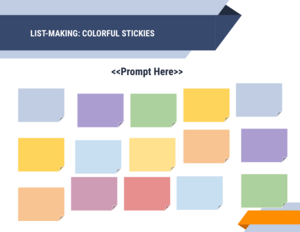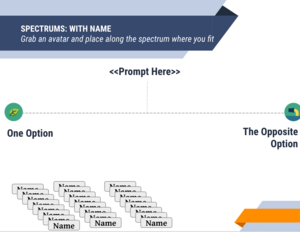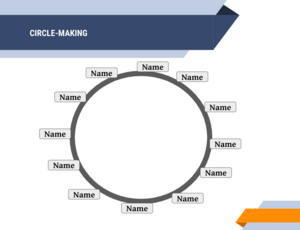Facilitation 101: Difference between revisions
| Line 102: | Line 102: | ||
The following sections include a compilation of suggestions from Seeds for Change''' <ref>https://www.seedsforchange.org.uk/facilitationmeeting</ref> '''''', '''Amara Possain (HUB advisor, Daniel Hunter (350.org training director) <ref>https://trainings.350.org/resource/online-monster-manual/</ref> and the Anarchist Library <ref>https://theanarchistlibrary.org/library/c-t-butler-and-amy-rothstein-on-conflict-and-consensus-a-handbook-on-formal-consensus-decisionm#toc76</ref> . Suggestions are relevant to virtual, in-person and hybrid meetings and events. | The following sections include a compilation of suggestions from Seeds for Change''' <ref>https://www.seedsforchange.org.uk/facilitationmeeting</ref> '''''', '''Amara Possain (HUB advisor, Daniel Hunter (350.org training director) <ref>https://trainings.350.org/resource/online-monster-manual/</ref> and the Anarchist Library <ref>https://theanarchistlibrary.org/library/c-t-butler-and-amy-rothstein-on-conflict-and-consensus-a-handbook-on-formal-consensus-decisionm#toc76</ref> . Suggestions are relevant to virtual, in-person and hybrid meetings and events. | ||
== For discussion and idea raising == | == For discussion and idea raising == | ||
{| class="wikitable" style="font-size: 14.4px; width: 100%; height: 364px; border-color: #000000;" | {| class="wikitable" style="font-size: 14.4px; width: 100%; height: 364px; border-color: #000000;" | ||
|- | |- | ||
| style="width: 21.7495%; background-color: #c51f84; border-color: #000000;" | | | style="width: 21.7495%; background-color: #c51f84; border-color: #000000;" | | ||
<span style="color: #ffffff;" >'''Temperature check'''</span> | <span style="color: #ffffff;">'''Temperature check'''</span> | ||
| style="width: 78.2137%;" | | | style="width: 78.2137%;" | | ||
*A non-verbal quick way to gauge different levels of enthusiasm for a topic. | *A non-verbal quick way to gauge different levels of enthusiasm for a topic. | ||
| Line 111: | Line 111: | ||
*This has the benefit of getting quick and basic input from everyone in the room - including people who don't often speak. A temperature check isn't the same thing as a majority vote. For example, even if only one person really needs a break, it could still be a good time to stop! | *This has the benefit of getting quick and basic input from everyone in the room - including people who don't often speak. A temperature check isn't the same thing as a majority vote. For example, even if only one person really needs a break, it could still be a good time to stop! | ||
|- | |- | ||
| style="width: 21.7495%; background-color: #c51f84; border-color: #000000;" | <span style="color: #ffffff;" >'''Go-arounds'''</span> | | style="width: 21.7495%; background-color: #c51f84; border-color: #000000;" | <span style="color: #ffffff;">'''Go-arounds'''</span> | ||
| style="width: 78.2137%;" | | | style="width: 78.2137%;" | | ||
*<p>Best reserved for smaller meetings. Everyone takes turns speaking without comment from others. This helps to gather opinions and feelings, and ensures everyone has a chance to speak.</p> | *<p>Best reserved for smaller meetings. Everyone takes turns speaking without comment from others. This helps to gather opinions and feelings, and ensures everyone has a chance to speak.</p> | ||
|- | |- | ||
| style="width: 21.7495%; background-color: #c51f84; border-color: #000000;" | <span style="color: #ffffff;" >'''Fishbowl'''</span> | | style="width: 21.7495%; background-color: #c51f84; border-color: #000000;" | <span style="color: #ffffff;">'''Fishbowl'''</span> | ||
| style="width: 78.2137%;" | | | style="width: 78.2137%;" | | ||
*The fishbowl is a special form of small group discussion. Some members representing differing points of view meet in the middle of the room, and create a circle to discuss the issue. Everyone else forms an outer circle and listens. | *The fishbowl is a special form of small group discussion. Some members representing differing points of view meet in the middle of the room, and create a circle to discuss the issue. Everyone else forms an outer circle and listens. | ||
*At the end of the discussion, the whole group reconvenes and evaluates the fishbowl discussion. | *At the end of the discussion, the whole group reconvenes and evaluates the fishbowl discussion. | ||
|- | |- | ||
| style="width: 21.7495%; background-color: #c51f84; border-color: #000000;" | <span style="color: #ffffff;" >'''Paired listening or small groups'''</span> | | style="width: 21.7495%; background-color: #c51f84; border-color: #000000;" | <span style="color: #ffffff;">'''Paired listening or small groups'''</span> | ||
| style="width: 78.2137%;" | | | style="width: 78.2137%;" | | ||
*Participants can explore and formulate their own thoughts and feelings on an issue without interruption. | *Participants can explore and formulate their own thoughts and feelings on an issue without interruption. | ||
| Line 126: | Line 126: | ||
*Listeners offer a summary at the end, to check they've understood. <br>After a set time swap roles within the pairs. | *Listeners offer a summary at the end, to check they've understood. <br>After a set time swap roles within the pairs. | ||
|- | |- | ||
| style="width: 21.7495%; background-color: #c51f84; border-color: #000000;" | <span style="color: #ffffff;" >'''Use sticky notes | | style="width: 21.7495%; background-color: #c51f84; border-color: #000000;" | <span style="color: #ffffff;">'''Use sticky notes'''</span> | ||
| style="width: 78.2137%;" | | | style="width: 78.2137%;" | | ||
*Sticky notes (virtual on slides or in-person) can be used to allow participants to share ideas. | |||
[[image:Screen Shot 2023-07-07 at 11.05.40 AM.png|300x300px|center|middle|border]] | |||
|- | |||
| style="width: 21.7495%; background-color: #c51f84; border-color: #000000;" | <span style="color: #ffffff;">'''Journalling/individual reflection'''</span> | |||
| style="width: 78.2137%;" | | |||
*Journalling/individual reflection before coming into discussion is helpful, especially for those that need more time to process. We especially recommend this for big decisions or questions. | *Journalling/individual reflection before coming into discussion is helpful, especially for those that need more time to process. We especially recommend this for big decisions or questions. | ||
|} | |} | ||
Revision as of 22:02, 8 August 2023
This page was created to provide tips and suggestions for activists related to facilitating meetings and events. This guide reflects several questions the HUB community has raised on facilitation.
The information included comes from existing organizer databases and resources and advice from movement thinkers. A special thanks to HUB advisor Amara Possain, who thoughtfully shared their expertise with the HUB team. Their knowledge is shared throughout. We encourage readers to share further ideas on how this page can be expanded upon and improved.
This guide includes... definers of good vs bad facilitation, tools for good facilitation, suggestions for increasing participant engagement and suggestions for managing group dynamics.
What do we mean by facilitation? [1] [2]
The role of a facilitator is to drive meeting or event participants towards clarity. Facilitation move things forward and build momentum. Facilitators also bring participants back to the purpose of the event/meeting. Remembering your purpose is key, so that when someone is taking up too much space, the facilitator can remind that you'd like to bring us back to the purpose and our goals. -Amara Possain, HUB advisor
In other words, the role of a facilitator and the purpose of facilitation is to: Source: adapted from Meeting Facilitation: The No-Magic Method (Berit Lakey) and Seeds for Change.
|
Take responsibility for helping the group stay on track and move through the agenda within the available time. |
|
Suggest how to move the group forward, rather than making decisions or plans for the group. |
|
Regulate the flow of discussion. |
|
Track decisions and milestones, providing clarity on the group's journey, clarifying and summarizing points. |
|
Prioritize the collective needs and goals of the group over individual within the group. |
Note: A person who has strong opinions or significant investment in the decisions being made may find it challenging to facilitate effectively. In some situations, it can be helpful to have an external facilitator.
What makes for poor facilitation?
The following reflections were raised by CAN-RAC and HUB team members in a joint workshop developed and delivered by Amara Possain:
- No agenda, no steering, lack of organization
- Repetition
- Lack of momentum
- Not stepping in to help pull out the positives (groups tend to focus on negatives)
- Not stepping in when some people are taking up too much space
- Not knowing the audience and how to tailor facilitation
- Not stepping in to get people back on track, when people hijack space
- Low engagement and energy, lack of initiative
- Not being able to move past certain items
- People weaponizing meeting rules and knowledge of process
- Passive aggressiveness
- Unclear roles in non-hierarchical structure
- Interrupting each other
- “Outfacilitating" the facilitator - often around an unbalanced power dynamic
- Miscommunications / inability to diagnose where we departed in understanding
Key facilitation skills [3]
- Active listening enables us to hear what others are saying;
- Questioning helps clarify what people are saying, or supports people to explore their needs and come up with new possibilities;
- Summarising helps remind us of the key points in the discussion and check we have the same understanding;
- Synthesising is the skill that allows us to draw together different views and ideas to form one proposal that works for everyone.
Good facilitation should result in good meetings with [4] :
- Clearly defined and mutually understood goals.
- A well-defined process for effectively achieving those goals.
- Recognition that participants bring their personal preoccupations and emotions alongside their interest in the subject matter.
- Fostering a sense of involvement and empowerment, allowing participants to feel ownership over the decisions and able to take necessary actions.
Tools for good facilitation
Stop and POP [5]
Source: adapted by Amara Possain (HUB advisor) from The P-O-P Model (Social Transformation Project, Leslie Sholl Jaffe & Randy Alford)
| Purpose |
Why? Why are we having this meeting? What is the purpose? |
|
Outcomes |
What do we want to accomplish as a result of this meeting? |
|
Process |
What steps will we take to achieve these outcomes and fulfill the purpose? |
Facilitation techniques
The following sections include a compilation of suggestions from Seeds for Change' [6] ', Amara Possain (HUB advisor, Daniel Hunter (350.org training director) [7] and the Anarchist Library [8] . Suggestions are relevant to virtual, in-person and hybrid meetings and events.
For discussion and idea raising
For feedback
For opening and beginning the meeting/event
For ending meeting/events
- Make sure you finish on time, or get everyone’s agreement to continue.
- Ensure someone will be circulating the minutes, notes or slides in the next few days.
- Make sure there’s a time and place set for the next meeting, or share upcoming events!
- Offer a way to evaluate and provide feedback the meeting/event.
- It can be nice to follow the meeting with an informal social activity!
Energizers to increase engagement throughout
Energizers provide a break/rest and can help increase engagement when included between the beginning to the end of a meeting/event [9]
|
Sam Went to Venus |
|
|
Something True About Yourself (from Gerald Gomani, Zimbabwe) |
|
|
Strategy Stretch (from Erika Thorne, USA) |
|
|
Why… Because… (from Gerald Gomani, Zimbabwe) |
|
Suggestions for managing group dynamics
From Amara Possain, HUB advisor and Meeting Facilitation: The No-Magic Method (Berit Lakey)
| Setting the tone |
|
| Specific practices |
|
|
Handling specific situations |
|
If you have any suggested revisions or additional resources to share related to the above content, please email them to kenzie@lehub.ca.

- ↑ https://www.trainingforchange.org/training_tools/meeting-facilitation-the-no-magic-method/
- ↑ https://www.seedsforchange.org.uk/facilitationmeeting
- ↑ https://www.seedsforchange.org.uk/facilitationmeeting
- ↑ https://www.trainingforchange.org/training_tools/meeting-facilitation-the-no-magic-method/
- ↑ http://stproject.org/
- ↑ https://www.seedsforchange.org.uk/facilitationmeeting
- ↑ https://trainings.350.org/resource/online-monster-manual/
- ↑ https://theanarchistlibrary.org/library/c-t-butler-and-amy-rothstein-on-conflict-and-consensus-a-handbook-on-formal-consensus-decisionm#toc76
- ↑ https://trainings.350.org/resource/gamesenergizersdynamicas/


